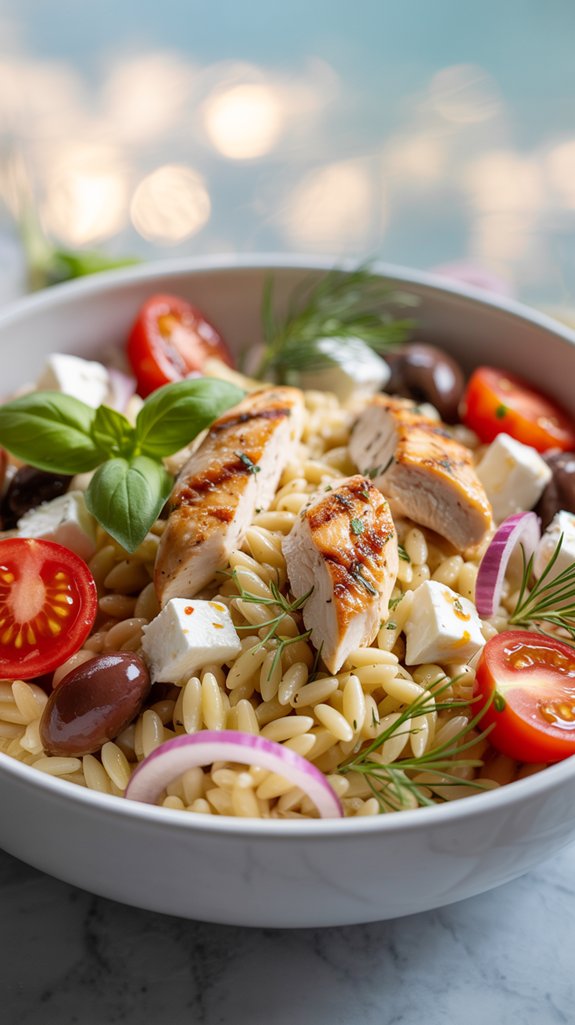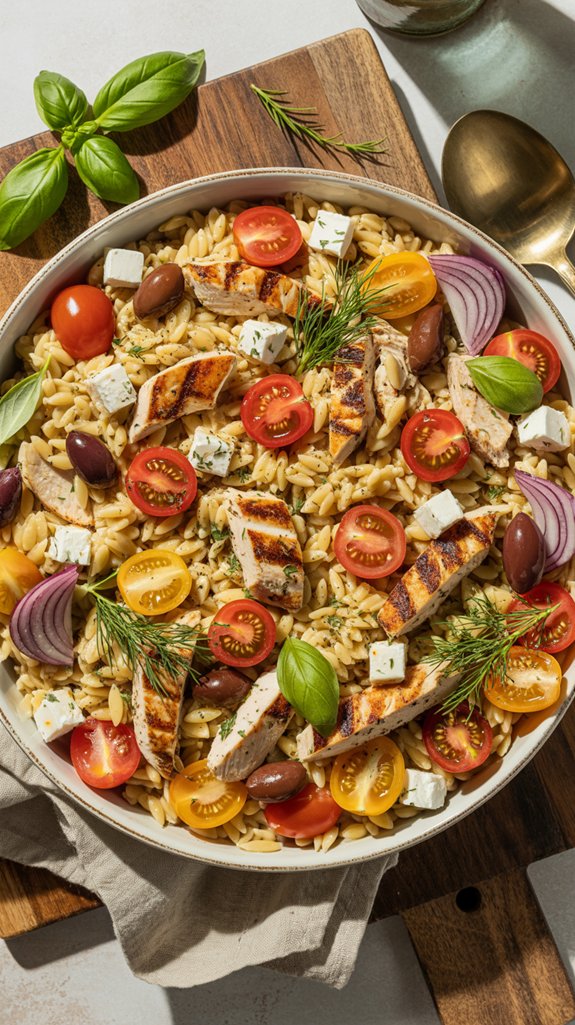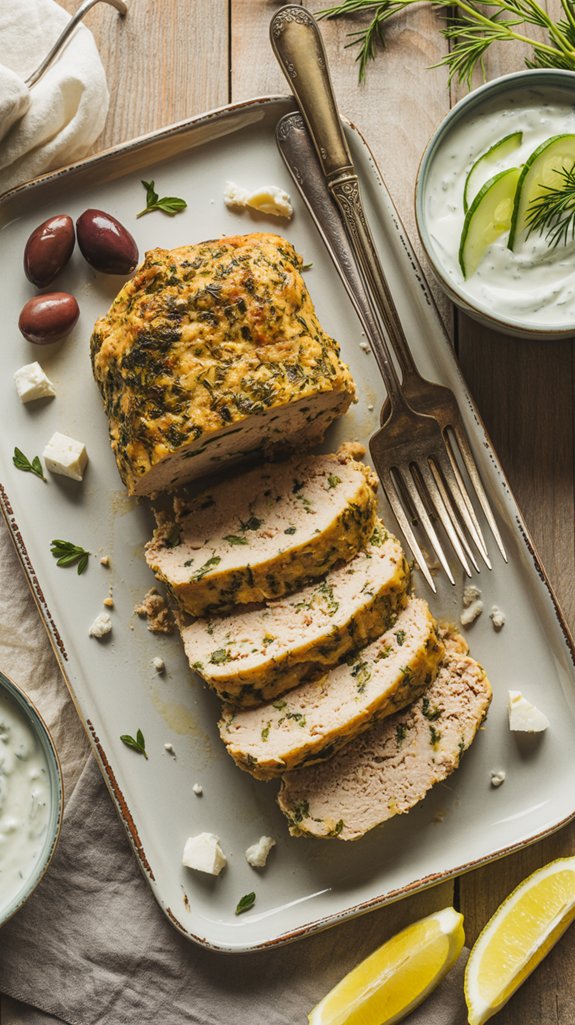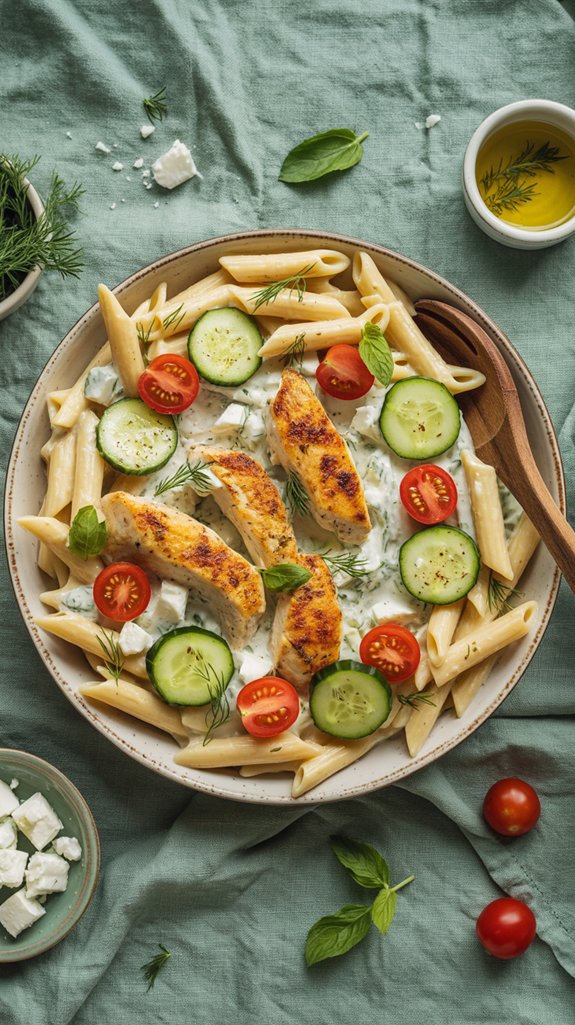Why You’ll Love This this Mediterranean Chicken Feta Orzo Salad
This Mediterranean orzo salad is like a Greek vacation on a plate, with tender chunks of seasoned chicken mingling with tangy feta and fresh herbs.
The beauty of this recipe lies in its flexibility – you can eyeball the dressing ingredients until it tastes just right, making it perfect for those of us who cook by feel rather than strict measurements.
Plus, it actually gets better as it sits in the fridge, which means you can make it ahead and let those Mediterranean flavors work their magic while you do literally anything else.
Ingredients List
For this Mediterranean orzo salad, you’ll need just a handful of fresh, wholesome ingredients that come together to create something truly special.
- 1 (16 ounce) box orzo pasta
- 1 lb boneless skinless chicken breast
- 2 large tomatoes, chunky dice
- 1 small red onion, small dice
- 1 (4 ounce) container crumbled feta cheese
- 2-3 tablespoons red wine vinegar
- 2-3 tablespoons olive oil
- 1-2 garlic cloves, minced super fine
- Salt and pepper
- 1/2 cup Italian parsley, chopped
Health considerations for this recipe:
- The lean chicken breast provides high-quality protein without excess saturated fat
- Olive oil delivers heart-healthy monounsaturated fats that your body actually craves
- Fresh tomatoes pack lycopene and vitamin C, while the parsley adds a surprising amount of vitamins A and K
- The feta cheese contributes calcium and probiotics, though it does add sodium to watch if that’s a concern
- Orzo pasta gives you energy-boosting carbs, and you could easily swap in whole wheat orzo for extra fiber
Step by Step Directions

Making this Mediterranean orzo salad is straightforward and requires just basic cooking techniques that anyone can master.
- Prepare the chicken: Season chicken breasts with salt, pepper, and garlic powder, then cook using your preferred method (grilling, baking, or pan-searing) until internal temperature reaches 165°F. Let cool completely, and dice into bite-sized chunks.
- Cook the orzo: Bring a large pot of salted water to boil, add orzo pasta and cook according to package directions until al dente. Drain thoroughly and rinse with cool water to stop cooking process, then drain again to remove excess water.
- Prepare vegetables: While chicken and pasta are cooking, dice tomatoes into chunky pieces, finely dice red onion, mince garlic cloves super fine, and chop Italian parsley.
- Make the dressing base: In a large mixing bowl, combine diced tomatoes, red onion, crumbled feta cheese, minced garlic, red wine vinegar, olive oil, chopped parsley, salt, and pepper.
- Combine everything: Add the cooled orzo pasta and diced chicken to the bowl with vegetables and dressing, then mix thoroughly to guarantee even distribution.
- Season and adjust: Taste the salad and adjust seasoning as needed, adding more vinegar for tartness, olive oil to prevent dryness, or salt and pepper to taste.
- Chill and serve: Refrigerate the salad for at least one hour to allow flavors to meld together before serving.
Using quality Mediterranean cookware sets can enhance your cooking experience when preparing the chicken and achieving the perfect texture for this dish.
Substitutions and Variations
- Herb variations: Fresh basil, oregano, or dill can replace parsley, depending on what’s not wilting in your crisper drawer right now.
- Dressing tweaks: Lemon juice instead of red wine vinegar creates a brighter flavor, or try balsamic vinegar if you want something a little sweeter and more mellow.
- Add some crunch: Toasted pine nuts, slivered almonds, or even sunflower seeds give this salad some textural interest that keeps every bite from feeling the same.
Additional Things to Serve With This Dish
This salad plays beautifully with so many other dishes, whether you’re serving it as a side or making it the star of your table.
- Grilled meats: This pairs wonderfully alongside grilled lamb, pork tenderloin, or even a simple grilled steak when you want the salad to be more of a supporting player.
- Mediterranean mezze spread: Serve it with hummus, pita bread, olives, and maybe some stuffed grape leaves for a full Greek taverna atmosphere in your backyard.
- Simple soups: A bowl of lemon rice soup or even a basic chicken broth makes this feel like a more complete meal without overwhelming anyone.
- Crusty bread: Honestly, just some good bakery bread and maybe a little olive oil for dipping turns this into the kind of casual dinner that feels effortless but satisfying.
- Roasted vegetables: Zucchini, eggplant, or bell peppers roasted with herbs complement the Mediterranean flavors without competing for attention.
- Light fish dishes: Grilled salmon or baked cod work really well here, especially if you’re trying to keep things on the lighter side but still want everyone to leave the table happy.
Cooking Tips & Tricks (Chef’s Notes)
Getting this salad just right comes down to a few key moves that’ll save you from the most common pitfalls.
- Don’t skip the cooling step for your orzo – hot pasta will turn your feta into a melty mess and wilt your parsley faster than you can say “oops.” I drain mine, rinse with cold water, then let it sit in the colander for a good five minutes while I prep everything else.
- Season your chicken while it’s still warm – it absorbs flavors so much better this way, and you won’t end up with bland protein hiding in an otherwise flavorful salad.
- Go easy on the dressing at first – you can always add more, but you can’t take it back once that orzo starts drinking up all that olive oil and vinegar like a thirsty sponge.
- Mince that garlic super fine – nobody wants to bite into a chunk of raw garlic, trust me on this one. I use my microplane grater, but a good sharp knife and some patience works just as well.
- Let it rest in the fridge – this isn’t one of those salads you can throw together and serve immediately. The flavors need time to mingle and get acquainted, kind of like a good dinner party.
- Taste and adjust before serving – that pasta keeps absorbing dressing even in the fridge, so you might need a splash more vinegar or oil to bring it back to life.
Nutritional Facts
This Mediterranean Chicken Feta Orzo Salad delivers a well-balanced mix of protein, complex carbs, and healthy fats in every serving.
- Calories per serving: Approximately 485 calories (based on 6 servings)
- Protein powerhouse: Each serving provides about 28 grams of complete protein from the chicken and feta cheese
- Carbohydrate content: Around 52 grams per serving, primarily from the orzo pasta
- Healthy fats: Contains approximately 18 grams of fat, with most coming from heart-healthy olive oil and some from the feta
- Fiber boost: Provides about 3 grams of fiber from the pasta, tomatoes, and parsley
- Sodium consideration: Contains roughly 580mg of sodium per serving, mainly from the feta cheese
- Vitamin C source: Fresh tomatoes and parsley contribute significant vitamin C for immune support
- Calcium contribution: Feta cheese adds about 140mg of calcium per serving for bone health
- Iron content: Chicken provides heme iron, which is easily absorbed by the body
- Low sugar: Contains only natural sugars from tomatoes and onions, totaling about 6 grams per serving
- Mediterranean diet approved: Rich in ingredients associated with heart health and longevity
Fun “Did You Know?”
Did you know that orzo isn’t actually rice, despite its grain-like appearance? It’s a pasta shaped like large rice grains!
I find it fascinating that feta cheese was traditionally stored in wooden barrels or natural caves to age properly.
Here’s another cool fact: the Mediterranean diet, which this salad represents, has been linked to increased longevity and reduced heart disease risk.
Red wine vinegar, one of our key ingredients, was actually found by accident when wine was left exposed to air too long.
These simple ingredients carry centuries of culinary history!





